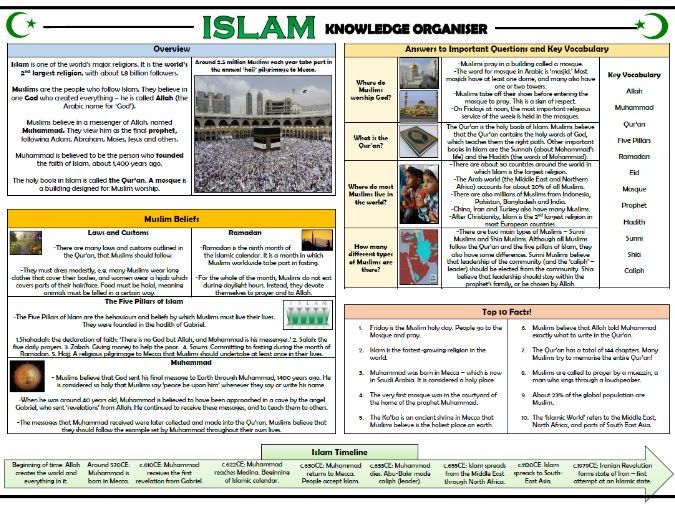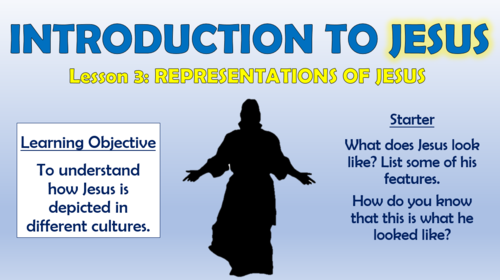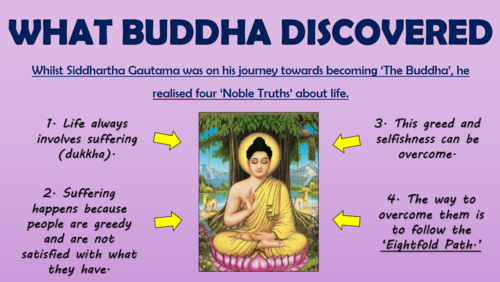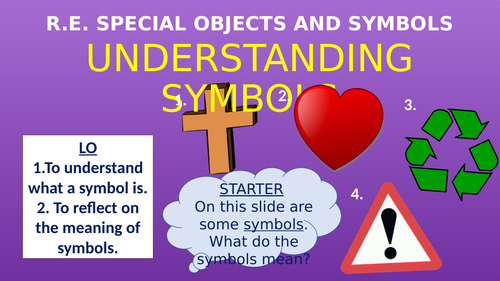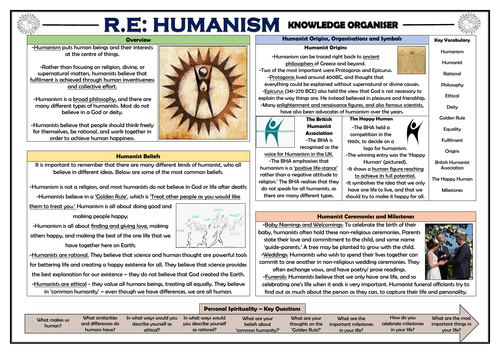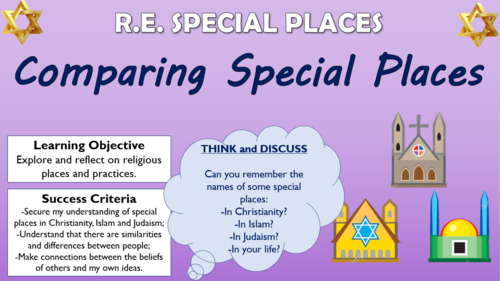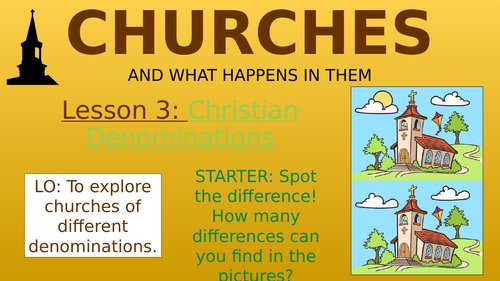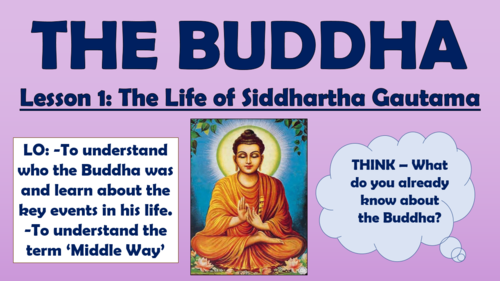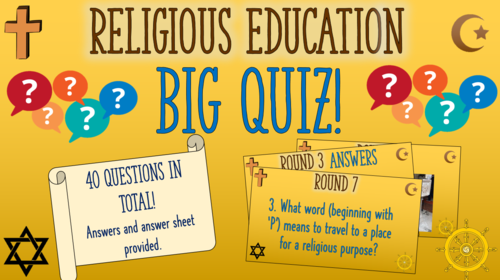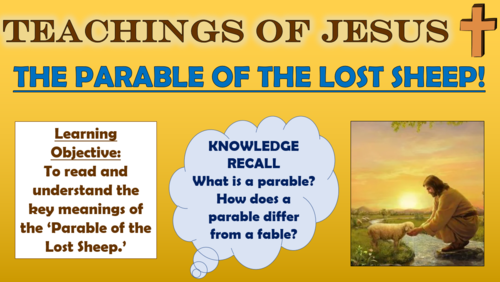
3k+Uploads
1918k+Views
2246k+Downloads
Religious education

KS1 RE - My Special Places!
In this engaging lesson, students consider the places that are important to them. The lesson serves as a foundation for children’s later learning about places that are special to people of different faiths.
The learning is guided by a clear and colourful PowerPoint presentation, which guides students through the following step-by-step journey:
-Discussing the differences between a house and a home;
-Considering what features make a home a special place to many people;
-Identifying the things that make their own homes a special place;
-Brainstorming other places that people may consider as special, e.g. their town or their school;
-Understanding that different people are individuals, and have their own opinions of places that are special;
-Completing a plenary activity to assess their understanding;
-Self-reflecting on the extent to which they feel they have met the learning objective.
This resource pack includes the comprehensive PowerPoint presentation (17 slides) and the template for the main special places activity (provided in Word and PDF). There is everything that you need here to teach the lesson.
In the past, I have used this lesson with children from across Key Stage 1 - the key learning is aligned with curriculum expectations for RE, and also the content prescribed by most diocese regions. All images are licensed for commercial use.

Buddhism Knowledge Organiser!
This detailed and visually-appealing resource offers a complete reference point for students learning about/ revising their understanding of Buddhism. It contains comprehensive sections under the following headings:
-Buddhism Overview;
-Buddhist Beliefs;
-Buddhism Timeline;
-Key Vocabulary;
-Top Ten Facts;
-Answers to the Important Questions.
Key words and ideas are underlined for easy reference. The resource is designed to be printed onto A3, and is provided as both a PDF and a Word version (so that you can edit if you want to).

Churches - The Features of Churches!
In this lesson, students learn about the key features of Anglican churches.
Some of the features covered include: the font, the altar, the pulpit, the lecturn, the nave, the crucifix and stained glass windows. Students learn about the key purpose of the features, and where they can be found in the church.
Students also begin to comprehend what the features symbolise.
This resource pack contains a comprehensive 16-slide Powerpoint, alongside an eye-catching worksheet. Two extension activities are provided in order to challenge higher ability learners.
In the past, I have used this lesson with children from across Key Stage 2 - the key learning is aligned with NC expectations for RE, and also the content prescribed by most diocese regions. All images are licensed for commercial use, and are cited on the final slide.
Bundle Sale

Major Religions Knowledge Organisers Bundle!
These clear, detailed and visually-appealing resources offer a complete reference point for students learning or revising knowledge relating to each of the world’s major religions, including:
Buddhism
Christianity
Islam
Judaism
Sikhism
Hinduism
Each organiser contains a number of comprehensive sections to guide learning and revision including:
Religion Overview;
Beliefs;
Timelines;
Important Vocabulary;
Answers to the Important Questions;
Top Ten Facts.
The resources are designed to be printed onto A3, and are provided as both PDF and Word versions (so that you can edit if you want to). All images used are licensed for commercial use and are cited on a separate document (included). The knowledge organisers may be used for students of all ages, but are most suitable for children in upper KS2 and lower KS3.

Sikhism Knowledge Organiser!
This detailed and visually-appealing resource offers a complete reference point for students learning about/ revising their understanding of Sikhism. It contains comprehensive sections under the following headings:
-Sikhism Overview;
-Sikh Beliefs;
-Sikhism Timeline;
-Key Vocabulary;
-Top Ten Facts;
-Answers to the Important Questions.
Key words and ideas are underlined for easy reference. The resource is designed to be printed onto A3, and is provided as both a PDF and a Word version (so that you can edit if you want to).

Islam Knowledge Organiser!
This detailed and visually-appealing resource offers a complete reference point for students learning about/ revising their understanding of Islam. It contains comprehensive sections under the following headings:
-Islam Overview;
-Islamic Beliefs;
-Islam Timeline;
-Key Vocabulary;
-Top Ten Facts;
-Answers to the Important Questions.
Key words and ideas are underlined for easy reference. The resource is designed to be printed onto A3, and is provided as both a PDF and a Word version (so that you can edit if you want to).

Introducing Jesus - Representations of Jesus!
In this engaging lesson, students develop their understanding of how Jesus Christ is visually depicted in paintings, focusing on facial expression, body language, his effect on his immediate environment, and other features. They also begin to look at how Jesus has been depicted over time and in different cultures.
The learning is guided by a clear and colourful PowerPoint presentation, which guides students through the following step-by-step journey:
-Personal Spirituality - considering how people (including themselves) can be represented;
-Understanding how no one today knows for sure how Jesus looked, and the paintings that we see of him are artists’ representations;
-Analysing how Jesus is represented in some famous paintings of different events in his life;
-Creating their own painting of Jesus from an event in his life, considering how Jesus himself is represented.
This resource pack contains a comprehensive Powerpoint, alongside an eye-catching, and helpful worksheet.
In the past, I have used this lesson with children from across Key Stage 2 - the key learning is aligned with curriculum expectations for RE, and also the content prescribed by most diocese regions. All images are licensed for commercial use.

The Buddha - The Eightfold Path!
In this engaging lesson, students gain a deeper understanding of the Noble Eightfold Path - the eight practices governing the lives of Buddhists.
The learning is guided by a clear and colourful PowerPoint presentation, which guides students through the following step-by-step journey:
-Defining what the Eightfold Path is;
-Breaking down the different practices that make up the Eightfold Path;
-Establishing why Buddhists follow the Eightfold Path;
-Thinking about how they can apply the principles of the Eightfold Path to their own lives;
-Considering a deeper thinking extension question;
-Completing a plenary to assess their understanding.
This resource pack contains a comprehensive Powerpoint, alongside an eye-catching worksheet.
In the past, I have used this lesson with children from across Key Stage 2 - the key learning is aligned with curriculum expectations for RE, and also the content prescribed by most diocese regions. All images are licensed for commercial use.

Understanding Symbols - KS1 RE Lesson!
In this engaging and informative lesson, children learn what symbols are, and begin to interpret and reflect on the meaning of symbols. They apply this knowledge in creating their own symbols, considering what the objects/ animals, colours and shapes that they select represent.
I used this as an introductory lesson, before then going into more depth about different religious symbols in the subsequent lessons. Children enjoyed it and it gave them a solid understanding of symbols to build on in the next steps of their learning.
This resource pack contains a comprehensive and colourful 15-slide Powerpoint, which guides teachers and students through the learning activities. A template worksheet is also provided (in Word and PDF) for the students to create and describe their symbol.
In the past, I have used this lesson with children in both Years 1 and 2 - the key learning is aligned with national expectations for RE, and also the content prescribed by most diocese regions. All images are licensed for commercial use, and are cited on the final slide.

Humanism Knowledge Organiser!
This clear, detailed and visually-appealing resource offers a complete reference point for children learning about Humanism in R.E. It contains comprehensive sections on:
-Overview;
-Humanist Beliefs;
-Origins, Organisations and Symbols in Humanism;
-Humanist Milestones and Ceremonies;
-Personal Spirituality - Key Questions;
-Key Vocabulary.
The resource is designed to be printed onto A3, and is provided as both a PDF and a Word version (so that you can edit if you want to). All images used are licensed for commercial use and are cited on a separate document (included). It is most appropriate for KS2 children.
Bundle Sale

Subject Foundations in EYFS - Knowledge Organisers Bundle!
These clear, detailed and visually-appealing resources help to detail and categorise the EYFS foundation learning in each of the primary curriculum subject areas
It is an important resource for EYFS teachers and parents, but also subject leaders, to aid them in the development of a clearly-mapped and well-sequenced subject curriculum across the school.
This organiser groups the subject-related learning into the relevant EYFS areas of learning (e.g. Understanding the World, Expressive Arts and Design, Communication and Language, etc.)
The resources are designed to be printed onto A3, and are provided as both PDF and Word documents (so that you can edit if you want to). All images used are licensed for commercial use and are cited on a separate document (included).

KS1 RE - Comparing Special Places!
In this engaging lesson, students develop their understanding of special places in Christianity, Islam and Judaism. It was originally taught as a part of an RE unit on ‘Special Places’ and so assumes some prior knowledge of churches and mosques (I have uploaded the prior lessons on this). The lesson introduces synagogues.
The learning is guided by a clear and colourful PowerPoint presentation, which guides students through the following step-by-step journey:
-Knowledge recall - gauging what children already know about special places in Christianity and Islam;
-Being introduced to synagogues and their key features;
-Using a provided worksheet/ template to find similarities and differences between churches, mosques and synagogues;
-Creating their own special places;
-Completing a plenary activity to assess their understanding;
-Self-reflecting on the extent to which they feel they have met the learning objective.
This resource pack includes the comprehensive PowerPoint presentation (23 slides) and the worksheet (provided in both Word and PDF). There is everything that you need here to teach the lesson, but you may wish to have some cardboard, shoeboxes etc. available for the creative task.
In the past, I have used this lesson with children from across Key Stage 1 - the key learning is aligned with curriculum expectations for RE, and also the content prescribed by most diocese regions. All images are licensed for commercial use.

Churches - Christian Denominations!
In this lesson, students learn about the a number of the main types of Christianity, including Protestant (Anglican), Roman Catholic and Orthodox denominations.
Children learn about why there are different kinds of Christianity, before exploring the features of each faith and the respective churches.
This resource pack contains a comprehensive 14-slide Powerpoint, alongside all of the resources needed. A creative extension activity is also provided in order to challenge higher ability learners.
In the past, I have used this lesson with children from across Key Stage 2 - the key learning is aligned with NC expectations for RE, and also the content prescribed by most diocese regions. All images are licensed for commercial use, and are cited on the final slide.
Note - children will need access to computers/ books in order to complete the research task.

Judaism Knowledge Organiser!
This detailed and visually-appealing resource offers a complete reference point for students learning about/ revising their understanding of Judaism. It contains comprehensive sections under the following headings:
-Judaism Overview;
-Jewish Beliefs;
-Judaism Timeline;
-Key Vocabulary;
-Top Ten Facts;
-Answers to the Important Questions.
Key words and ideas are underlined for easy reference. The resource is designed to be printed onto A3, and is provided as both a PDF and a Word version (so that you can edit if you want to).

Hinduism Knowledge Organiser!
This detailed and visually-appealing resource offers a complete reference point for students learning about/ revising their understanding of Hinduism. It contains comprehensive sections under the following headings:
-Hinduism Overview;
-Hindu Beliefs;
-Hinduism Timeline;
-Key Vocabulary;
-Top Ten Facts;
-Answers to the Important Questions.
Key words and ideas are underlined for easy reference. The resource is designed to be printed onto A3, and is provided as both a PDF and a Word version (so that you can edit if you want to).

KS1 RE - Special Places - Mosques!
In this engaging lesson, students develop their understanding of churches and what happens in them. It was originally taught as a part of an RE unit on ‘Special Places.’
The learning is guided by a clear and colourful PowerPoint presentation, which guides students through the following step-by-step journey:
-Knowledge harvesting what children already know about mosques, and what they would like to find out;
-Learning the basics about Mosques, before reading and comprehending ‘An Important Job for Qaswa the Camel’ - an age-appropriate story about the first mosque;
-Studying a number of images of different features in mosques and discussing why each feature is important;
-Understanding what makes mosques special places to Muslims, and finding similarities and differences between mosques and churches;
-Completing a plenary activity to assess their understanding;
-Self-reflecting on the extent to which they feel they have met the learning objective.
This resource pack includes the comprehensive PowerPoint presentation (24 slides) and the story for the comprehension activity (provided in Word and PDF). There is everything that you need here to teach the lesson.
In the past, I have used this lesson with children from across Key Stage 1 - the key learning is aligned with curriculum expectations for RE, and also the content prescribed by most diocese regions. All images are licensed for commercial use.

The Buddha - The Life of Siddhartha Gautama!
In this engaging lesson, students are introduced to who Siddhartha Gautama was, and learn how he became the Buddha. They also begin to discuss the ‘Middle Way’, and consider how these ideas can be applied to modern life.
The learning is guided by a clear and colourful PowerPoint presentation, which guides students through the following step-by-step journey:
-Knowledge harvesting - gauging what children already know about the Buddha;
-Watching a short video (hyperlinked) about the life of Siddhartha Gautama;
-Explaining the key events in his life, using a storyboard template;
-Discussing what is meant by the ‘Middle Way’, and how this helped Gautama to find enlightenment;
-Thinking about how they can apply the ideas of the ‘Middle Way’ to their own lives;
-Considering a deeper thinking extension question;
-Completing a plenary to assess their understanding.
This resource pack contains a comprehensive Powerpoint, alongside an eye-catching worksheet.
In the past, I have used this lesson with children from across Key Stage 2 - the key learning is aligned with curriculum expectations for RE, and also the content prescribed by most diocese regions. All images are licensed for commercial use.

Religious Education Big Quiz! (KS2/KS3)
This wide-ranging and comprehensive RE quiz contains 40 questions. It was originally designed for high attaining year 5/6 classes as an end of term activity, but may also be suitable for lower KS3 groups.
Questions are split into 8 rounds of 5 questions each. To add variety and promote engagement, there are a range of regular, true or false, multiple choice and picture questions. Answers are given at the end of each round. The rounds included are:
1.) Churches
2.) Jesus Christ
3.) Islam
4.) Buddhism
5.) Judaism
6.) Hinduism
7.) Religion around the World
8.) Final Round Lucky Dip
A team answer sheet is included, provided in both Word and PDF.

KS1 RE - The Life of a Vicar!
In this engaging lesson, students develop their understanding of the roles of vicars. They consider their routines and actions, and how vicars live their daily lives. It is great as a standalone lesson, or as a part of a unit on ‘special ways of living.’
The learning is guided by a clear and colourful PowerPoint presentation, which guides students through the following step-by-step journey:
-Thinking about the definition of a vicar (and how this differs from the more general definition of a priest;
-Introducing children to the daily life of vicars, including discussing their many roles and responsibilities, through watching an interesting and age-appropriate video;
-Answering questions to check their understanding of the roles of vicars;
-Completing a storyboard (using a provided template) to show the daily routine of vicars;
-Learning about the different clothes worn by vicars, before drawing and labelling a vicar in uniform;
-Considering questions that they would ask to a vicar if they were given the opportunity (you could email these to your local vicar, or even better, invite them in for a Q and A session);
-Self-reflecting on the extent to which they feel they have met the learning objectives.
This resource pack includes the comprehensive PowerPoint presentation (15 slides) the template for the storyboard, and the hyperlink for the video explaining about the daily life of a vicar. There is everything that you need here to teach the lesson.
In the past, I have used this lesson with children from across Key Stage 1 - the key learning is aligned with curriculum expectations for RE, and also the content prescribed by most diocese regions. All images are licensed for commercial use.

Teachings of Jesus - The Parable of the Lost Sheep!
In this engaging lesson, students read and interpret ‘The Parable of the Lost Sheep.’
The learning is guided by a clear and colourful PowerPoint presentation, which guides students through the following step-by-step journey:
-Knowledge recall - remembering key facts about Jesus’ life and teaching;
-Discussing why Jesus’ parables continue to give important messages;
-Watching an engaging, age-appropriate video of the parable;
-Interpreting the parable through comprehension questions, and deciphering its key meanings;
-Using the storyboard template provided to demonstrate their understanding of the parable and its morals;
-Considering the messages that they can take for their own lives from this parable;
-Self-reflecting on the extent to which they feel they have met the learning objective.
The resource pack includes everything you need to teach the lesson, including the comprehensive PowerPoint presentation and the storyboard template (provided in both Word and as a PDF). Just download and teach!
In the past, I have used this lesson with children from across Key Stage 2 with minor adaptations for age - the key learning is aligned with curriculum expectations for RE, and also the content prescribed by most diocese regions. All images are licensed for commercial use.






